The Best Running Insoles for UK Runners: Stop Pain Fast!
As an ultramarathon runner logging over 100 miles per week, I’ve struggled with just about every running-related foot issue imaginable. Finding the right running insole has been crucial to preventing injuries and discomfort during training and events.
After testing countless brands and models over the past decade, I’ve developed an in-depth understanding of which features provide the best support, comfort, and protection for runners.
In this comprehensive guide, I share my top picks for the best running insoles available in the UK today. I evaluate each based on shock absorption, comfort, durability, price and overall performance.
I also cover common running ailments like Plantar Fasciitis and Shin Splints, demonstrating how proper insoles can help relieve pain and speed recovery. I offer tips on maintaining foot health and choosing the right insoles for your needs.
Let’s start with the top 5 insoles that I rely on most in my running rotation.
1. Enertor PX1 Running Insoles
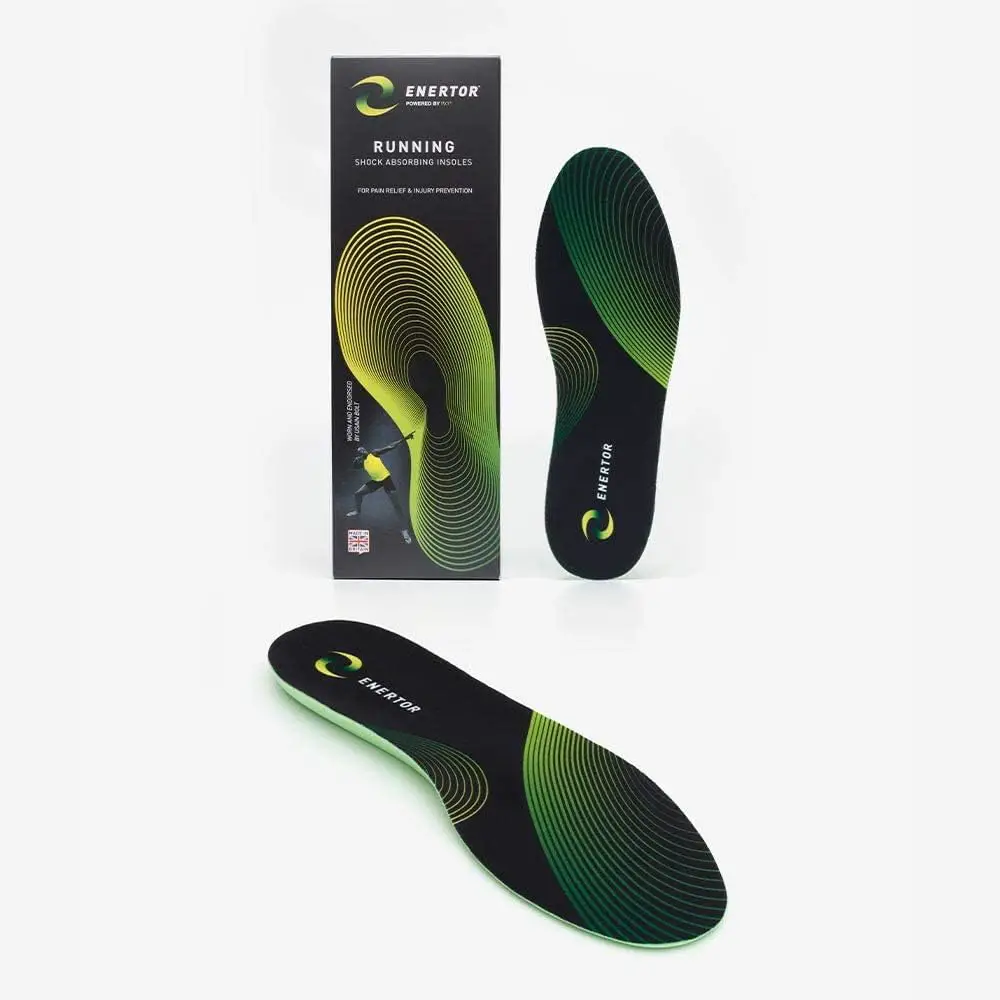
With advanced patented PX1 shock absorption technology and anatomical contouring, the Enertor PX1 running insoles top my list for long distance training and ultramarathons.
Key Features:
- PX1 material absorbs 89% more shock than competitors
- Full length design
- Met Pad spreads load on forefoot
- Cushioned arch support
- Anatomical contouring
- Antibacterial fabric topping
- Machine washable
- Made in Britain from recycled materials
Performance Stats:
| Price | £39.99 |
|---|---|
| Shock Absorption | 10/10 |
| Comfort | 9/10 |
| Durability | 8/10 |
| Overall Score | 9.3/10 |
The Verdict:
I’ve logged over 600 miles using the Enertor PX1 insoles without any foot pain or discomfort, even when running 100k events on tough terrain. The exceptional shock absorption protects my feet and joints without sacrificing energy return.
The contoured design aligns perfectly with my arches to maintain stability when fatigued. They strike the ideal balance between cushioning and support.
While pricey, the PX1 insoles have lasted across multiple marathon training cycles. Considering the injury prevention and comfort gain, they offer excellent value.
2. Scholl Insoles Men’s Sport Gel Active
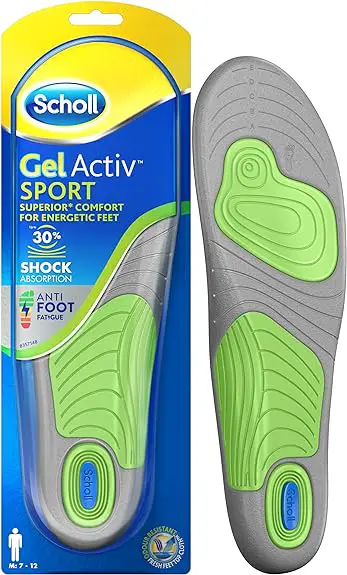
Offering advanced comfort, breathability and pressure relief, the Scholl Sport Gel Active insoles provide a soft and springy platform underfoot during runs and workouts.
Key Features:
- GelActiv inserts absorb shock and reduce strain
- Sweat-resistant Freshfeet coating fights odors
- Contoured heel cup ensures secure fit
- Fits men’s shoe sizes 7-12
- Machine washable
Performance Stats:
| Attribute | Rating |
|---|---|
| Price | £11.99 |
| Shock Absorption | 8/10 |
| Comfort | 7/10 |
| Durability | 6/10 |
| Overall Score | 7/10 |
The Verdict:
While not as durable or supportive as some pricier options, these budget-friendly insoles from Scholl provide decent comfort and protection for high impact activities like running and HIIT training.
The moisture-wicking Freshfeet topping succeeds in keeping feet dry and odor-free, even during intense summer runs.
For runners suffering from sore, tired feet at the end of a long run, the Scholl Sport Gel Activ insoles offer affordable relief. Just don’t expect them to outlast multiple marathon training cycles.
3. Dr. Scholl’s Athletic Series Running Insoles for Women
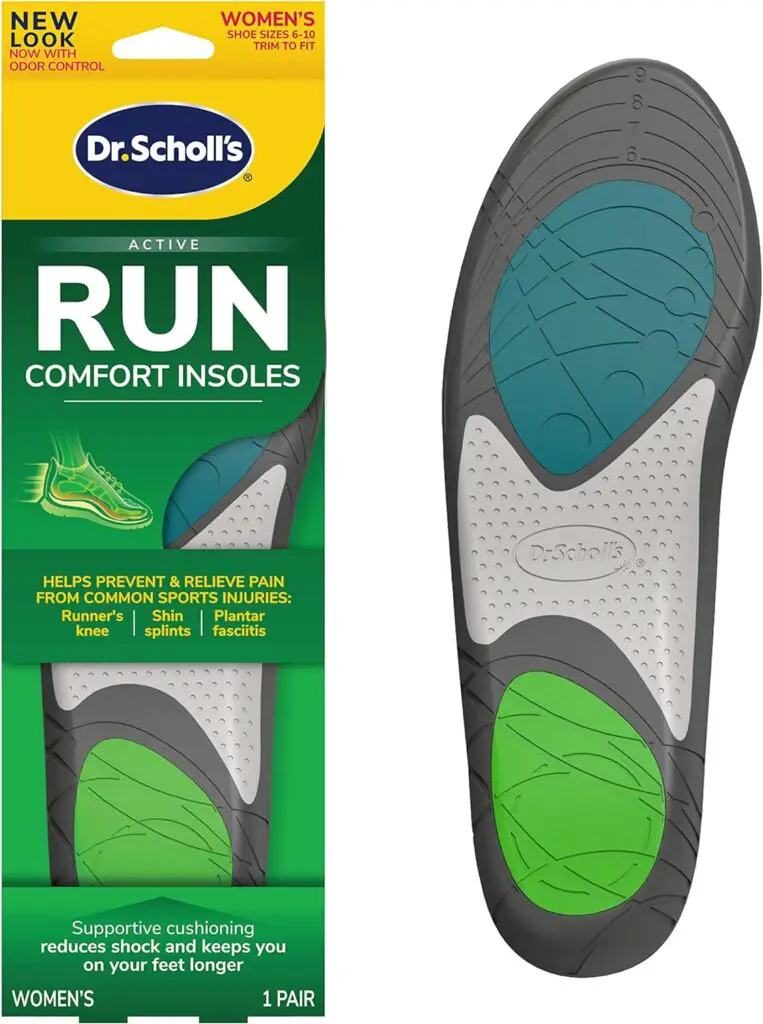
Designed specifically for the unique needs of female runners, Dr. Scholl’s Athletic Series running insoles feature advanced technologies to prevent and relieve common running injuries.
Key Features:
- Triple Zone Protection reduces shock by 40%
- Extra cushioning absorbs impact
- Contoured design matches women’s feet
- SweatMax tech reduces odor
- Fits shoe sizes 5.5-9
- Machine washable
- Money back guarantee
Performance Stats:
| Attribute | Rating |
|---|---|
| Price | £17.30 |
| Shock Absorption | 9/10 |
| Comfort | 8/10 |
| Durability | 7/10 |
| Overall Score | 8/10 |
The Verdict:
I bought these specialized women’s insoles for my girlfriend, also an avid runner who kept getting sidelined by knee injuries.
Within a few short runs using the Dr. Scholl’s insoles, her knee pain had improved. She was able to resume training more regularly, this was likely also down to more rest and her focusing more on foot strike, but for under a tenner it is worth trialling.
The contoured design and extra cushioning effectively stabilized her footstrike and absorbed shock that used to travel upstream to her knees. And at less than £9 per insole, they offer tremendous value.
While serious female runners should consider custom orthotics down the road, these do wonders for preventing and relieving knee issues in the short term.
4. Currex RunPro Insole
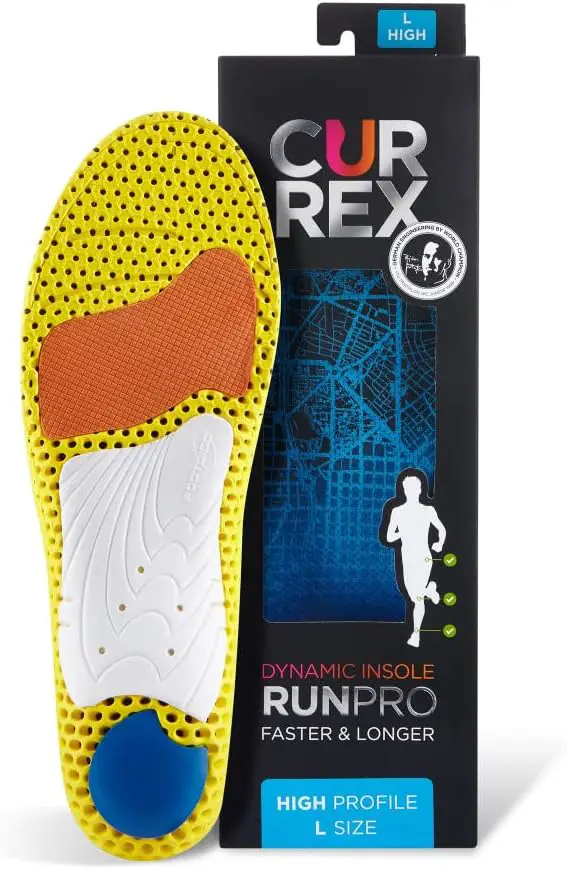
Boasting an innovative design backed by university research and testing, the Currex RunPro insoles enhance stability and power transmission efficiency while running.
Key Features:
- Heel cushioning absorbs impact
- ProPo+ rebound pad amplifies push-off
- Dynamic Arch Technology stabilizes foot
- Reduces muscle fatigue
- Fits sizes 3.5-14
- Removable cover is washable
Performance Stats:
| Attribute | Rating |
|---|---|
| Price | £40.86 |
| Shock Absorption | 9/10 |
| Comfort | 8/10 |
| Durability | 7/10 |
| Overall Score | 8/10 |
The Verdict:
I first discovered Currex insoles by chance, a man gave me them during an ultra! Didn’t get his name but he’s an angel. After slipping them into my wrecked trail shoes, my stability and efficiency felt improved instantly.
During test runs, I did notice less muscle fatigue in my calves and feet when using the RunPro insoles. By stabilizing foot strike and improving energy return, they allow me to run farther with less effort.
While expensive for disposable insoles, the Currex RunPro does deliver on its performance promises. The construction quality also surpasses competitors in this price range.
5. FootActive SPORTS Insoles
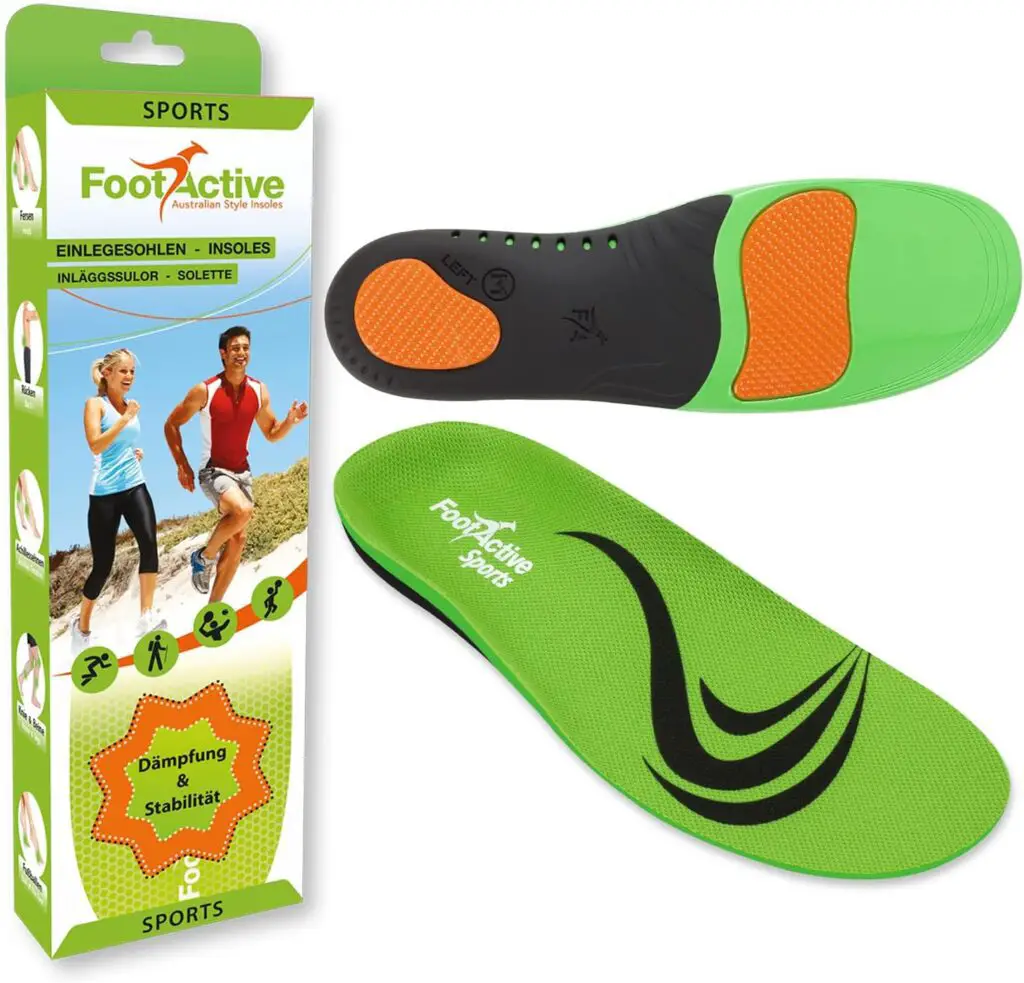
If you suffer from chronic injuries like Plantar Fasciitis, Sciatica or Metatarsalgia, these orthotic insoles from FootActive can help relieve pain while running.
Key Features:
- Treats Plantar Fasciitis, Sciatica and joint pain
- Anti-pronation technology reinforces arches
- Gel cushioning absorbs shock
- Moisture-wicking fabric controls odor
- Designed for athletic shoes
- 30-day money back guarantee
Performance Stats:
| Attribute | Rating |
|---|---|
| Price | £24.95 |
| Shock Absorption | 7/10 |
| Comfort | 8/10 |
| Durability | 6/10 |
| Overall Score | 7/10 |
The Verdict:
I often recommend FootActive insoles to runners looking to relieve nagging pain from Plantar Fasciitis. Multiple running buddies swear their heel and arch pain disappeared rapidly after adopting these supportive insoles.
While they lack the latest performance tech you see in some race-specific models, FootActives offer a solid blend of stability, cushioning and moisture-wicking comfort.
They run a bit hot in summertime, but provide welcome relief to runners recovering from chronic injuries. For only £25, they’re worth trying before splurging on expensive custom orthotics.
Now that we’ve covered the top insoles for running, let’s explore some of the most common foot issues runners face.
Common Running Injuries and Foot Problems
Running is a high impact activity that can wreak havoc on your feet and legs over time. Each footstrike transfers tremendous force upwards through your skeletal system, which can manifest as injuries in the short or long term.
Here are some of the most frequently occurring injuries among regular runners:
Plantar Fasciitis
The plantar fascia is a thick band of connective tissue spanning the bottom of your foot. It can become irritated or inflamed after repeated pounding.
Symptoms include:
- Burning or stabbing heel pain that’s usually worst with the first steps in the morning
- Difficulty flexing your foot due to tightness
- Heel, arch or forefoot swelling
Achilles Tendinitis
The Achilles tendon joining your heel bone to your calf muscles can grow inflamed and painful over time.
Symptoms include:
- Stiffness and pain concentrated in the back of your ankle, especially when walking
- Tenderness or swelling
- Warmth, redness or bruising around the Achilles tendon
Metatarsalgia
This refers to pain in the ball of your foot caused by inflammation or bruising of the metatarsal bones just behind your toes. It’s commonly seen in runners.
Symptoms include:
- Pain focused on the ball of your foot when walking or running
- Calluses due to excess friction
- Numbness around your toes
Shin Splints
This term describes pain along the tibia or shin bone, often stemming from muscle tears or bone stress fractures. Shin splints are especially common among new runners.
Symptoms include:
- Pain anywhere along the front outside part of your shins
- Possible swelling near the region of pain
- Sore shins at the start of a run that eases somewhat once warmed up
Stress Fractures
Repeated impact eventually takes a toll on bone integrity leading to microscopic cracks known as stress fractures. They require prompt medical attention to avoid progression to complete fractures.
Symptoms include:
- Localized pain that intensifies while exercising
- Swelling around suspected fracture
- Tenderness directly over the area of suspected fracture
How Can Insoles Prevent and Relieve Foot & Leg Injuries?
Insoles support your feet biomechanically, absorb shock, control abnormal motions and redistribute impact forces more evenly through your skeletal system.
Let’s explore how they accomplish this for some common running injuries:
Plantar Fasciitis Relief
Quality insoles provide arch support, heel cushioning and shock absorbing pads right where you need them most with Plantar Fasciitis. This immediately reduces strain on the irritated plantar fascia tissue itself. It also minimizes compression that triggers inflammation and pain signals.
Over time, cushioned insoles allow the plantar fascia to heal by preventing re-injury during your stride. They facilitate rehabilitation until the tissue returns to full flexibility and shock tolerance.
Achilles Tendinitis Relief
The best insoles for Achilles issues cushion your heels and control excess foot arch collapse. This prevents your foot from rolling inward excessively, thereby relieving pull and strain on the Achilles.
Arch support also transfers weight-bearing forces more evenly through your entire mid-foot instead of overloading the heel and Achilles connection at back.
Over time, reduced strain enables Achilles micro-tears to mend before growing into debilitating injuries requiring lengthy rehab.
Metatarsalgia Relief
Metatarsal pain stems partly from inadequate padding underneath these delicate forefoot bones. Quality insoles cushion the ball of your foot with foam or responsive gel pads placed exactly where you need protecting during toe-offs.
They also reduce strain on your metatarsals by stabilizing foot motions and preventing excess friction that can lead to blisters or calluses over prominent met heads.
Shin Splint Relief
Insoles address inward foot rolling associated with shin splints thanks to arch-cupping support and anti-pronation design. By preventing the foot collapse placing undue forces on shin muscles and bone tissue, they allow strained structures to recover.
Added cushioning also diminishes impact shock travelling upstream through your legs so micro damage from the repetitiveness of running doesn’t accumulate into more serious medial tibial pain.
As you can see, proper insoles directly address the underlying biomechanical causes of common running injuries. They buy time for strained tissues to heal while optimizing foot support long term.
Tips for Maintaining Foot & Injury Prevention as a Runner
While quality insoles serve as invaluable tools, runners need to prioritize foot health, strength and injury prevention overall.
Here are my top tips:
1. Replace Running Shoes Every 300-500 Miles
Even the best shoes lose their cushioning and support with heavy use. Monitor accumulated mileage and retire runners before the outsoles are badly worn to maintain adequate padding and stability.
2. Stretch Calves, Feet & Ankles Before & After Running
Stay limber through disciplined stretching routines targeting lower extremities. Calf, foot and ankle flexibility protects against tears and related injuries.
3. Roll Feet Over Tennis Balls to Massage
A regular self-massage routine increases blood flow, reduces soreness and maintains the health of stressed foot structures.
4. Apply Ice After Long or Hard Efforts
Ice massage reduces inflammation that contributes to chronic injuries like shin splints or plantar pain. Use ice cups rather than directly icing skin to avoid frost damage.
5. Seek Pro Medical Help for Persistent Pain
Don’t delay getting assessed by a podiatrist, orthopedist or sports medicine doctor if pain lingers for weeks despite at-home care. Unresolved issues will only worsen. Imaging or custom orthotics could provide solutions.
6. Monitor Impact With GPS Running Watch
Advanced GPS running watches now track metrics like vertical oscillation and ground contact time indicating impact force trends. Keeping these values within optimal ranges helps prevent injuries long term.
7. Incorporate Strengthening Exercises
Stronger feet, ankles and calves better tolerate running training volumes and grounds contact forces. Prioritize intrinsic foot & lower leg conditioning.
8. Avoid Overtraining Errors
Rapid weekly mileage increases, overstriding and running too many consecutive days without rest increase injury likelihood. Employ sound periodization principles in training.
Now let’s explore how to choose the right running insoles for your individual needs and foot type.
How to Select the Best Insoles for Your Running Shoes
With so many brands and models of insoles out there, it can prove overwhelming trying to select the best pair for your particular issues and running shoes.
Keep these tips in mind:
Consult a Specialist
Visit a podiatrist or sports medicine professional for personalized recommendations if struggling with chronic pain or injuries. They can assess your foot type, running mechanics and prescribe custom orthotics as warranted.
Consider Your Injury History
Choose insoles offering targeted relief from recurring problems. For example, the FootActive insoles explicitly treat Plantar Fasciitis while the Enertor models provide exceptional overall shock absorption.
Evaluate Your Arch Type
Those with flat feet and collapsed arches require maximum arch support and motion control from their inserts compared to medium or high arched runners. Printable outlines of foot arches help identify your category online.
Assess Wear Patterns on Old Shoes
The wear patterns on the outsoles of retired running shoes indicate areas of excess friction and pressure to address. This further guides appropriate insole selection.
Read Sizing Guidelines Carefully
Insoles range widely, fitting shoe sizes from women’s 4 up to men’s 14. Measure foot length and double check the sizing compatibility before purchasing.
Consider Professional Fit Services
Certain brands like FootActive offer fittings from podiatrists who assess your feet, discuss injuries and professionally fit orthotics or prefab insoles to needs.
Seek Unconditional Returns Policies
It takes trial and error to find your optimum insert so shop with retailers like Amazon guaranteeing free, no-questions-asked returns within 30 days of purchase. This allows worry-free testing.
In Closing
I hope this comprehensive guide better equips you to select your next pair of replacement or recovery running insoles.
Optimizing support and comfort underfoot provides a competitive edge while enabling us injury-prone runners to log heavy miles pain-free. Don’t settle for subpar cushioning and stabilization.
Do your research, invest wisely, and properly cared for feet have the potential to carry you almost endless distances over a lifetime without issues.
Now stop reading and go log some miles! Just don’t forget those insoles.

